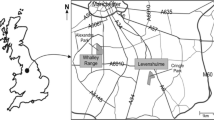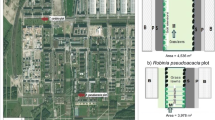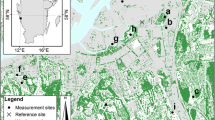Abstract
Street trees planted at tree pits with impermeable pavements are exposed to a high level of both, atmospheric and edaphic stress. For many species tree physiology, optimal growth, and consequently long-term vitality may be hampered under these harsh conditions. Therefore, maintaining the vitality and promoting the ecosystem services provided by urban trees, for example aesthetic values and microclimatic benefits, it is important to establish trees with a high tolerance to stressful urban environments. Measurements of leaf gas exchange, leaf water potential, leaf surface temperature and chlorophyll-fluorescence were used for identification of specific response of Corylus corluna L., Ginkgo biloba L., Liriodendron tulipifera L., and Tilia cordata Mill. ‘Greenspire’. The summer months in 2013 with a period of heat and drought over eight weeks only interrupted by two rainy days were appropriate to access tree’s strategies to cope with low water availability. During the measurement period, the influence of high temperatures, high values of vapor pressure deficit (VPD) and low soil water availability on stomatal conductance, water-use efficiency (WUE) and leaf water potential (Ψmin, Ψmax ) was highest for Liriodendron followed by Ginkgo. These species showed high reductions in WUE in case of higher air temperatures and high values of VPD. Results indicate an avoidance strategy under increasing heat and VPD. In contrast, Corylus and Tilia followed a tolerance strategy indicated by decreasing values of Ψmin and lower reductions of WUE. In conclusion, wide species-specific variation in response to high temperatures and high VPD indicates that substantial potential exists in the selection for dry and hot urban places.







Similar content being viewed by others
References
Aranda I, Cano FJ, Gascó A, Cochard H, Nardini A, Mancha JA, López R, Sánchez-Gómez D (2014) Variation in photosynthetic performance and hydraulic architecture across European beech (Fagus sylvatica L.) populations supports the case for local adaptation to water stress. Tree Physiol 34:1–14. doi:10.1093/treephys/tpu101
Armson D, Rahman MA, Ennos AR (2013) A comparison of the shading effectiveness of five different street tree species in Manchester, UK. Arboricult Urban For 39:157–164
Baker NR (2008) Chlorophyll fluorescence: a probe of photosynthesis in vivo. Annu Rev Plant Physiol 59:89–113. doi:10.1146/annurev.arplant.59.032607.092759
Bartens J, Day S, Harris J, Wynn T, Dove J (2009) Transpiration and root development of urban trees in structural soil stormwater reservoirs. J Environ Manag 44:646–657. doi:10.1007/s00267-009-9366-9
Bernhofer C, Matschullat J, Bobeth A (2009) Das Klima in der REGKLAM-Modelregion Dresden. Regklam Publikationsreihe Heft 1, Rhombos, Berlin
Bhaduri B, Minner M, Tatalovich S, Harbor J (2001) Long-term hydrologic impact of urbanization: a tale of two models. J Water Resour Plan Manag 127:13–19. doi:10.1061/(ASCE)0733-9496(2001)127:1(13)
Blume HP (2000) Böden städtisch-industrieller Verdichtungsräume. In: Blume HP, Felix-Henningsen P, Fischer WR, Frede HG, Horn R, Stahr K (eds) Handbuch der Bodenkunde. Ecomed, Landsberg, pp. 154–171
Bodenkunde AG (2005) Bodenkundliche Kartieranleitung. Schweizbart’sche Verlagsbuchhandlung, Stuttgart
Bush SE, Pataki DE, Hultine KR, West AG, Sperry JS, Ehleringer JR (2008) Wood anatomy constrains stomatal responses to atmospheric vapor pressure deficit in irrigated, urban trees. Oecologia 156:13–20. doi:10.1007/s00442-008-0966-5
Cavander-Bares J, Bazzaz FA (2000) Changes in drought response strategies with ontogeny in Quercus rubra: implications for scaling from seedlings to mature trees. Oecologia 124:8–18. doi:10.1007/PL00008865
Cekstere G, Osvalde A (2013) A study of chemical characteristics of soil in relation to street trees status in Riga Latvia. Urban For Urban Green 12:69–78. doi:10.1016/j.ufug.2012.09.004
Conway TM (2007) Impervious surface as an indicator of pH and specific conductance in the urbanizing coastal zone of New Jersey, USA. J Environ Manag 85:308–316. doi:10.1016/j.jenvman.2006.09.023
DWD (2013) Data obtained from the Climate Data Center of the Deutsche Wetterdienst (DWD) via online request ( www.dwd.de ) Accessed 12.01.2014
Elfving DC, Kaufmann MR, Hall AE (1972) Interpreting leaf water potential measurements with a model of the soil-plant-atmosphere continuum. Physiol Plant 27:161–168
Ferrini F, Baietto M (2006) Response to fertilization of different tree species in the urban environment. Arboricult Urban For 32:93–99
Fini A, Mattiiand GB, Ferrini F (2008) Physiological responses to different irrigation regimes for shade trees grown in container. Adv Hortic Sci 22:13–20
Fini A, Ferrini F, Frangi P, Amoroso G, Piatti R (2009) Withholding irrigation during the establishment phase affected growth and physiology of Norway maple (Acer platanoides) and linden (Tilia spp.). Arboricult Urban For 35:241–251
Flexas J, Diaz-Espejo A, Gago J, Gallé A, Galmés J, Gulías J, Medrano H (2014) Photosynthetic limitations in Mediterranean plants: a review. Environ Exp Bot 103:12–23. doi:10.1016/j.envexpbot.2013.09.002
Forrai M, Vértesy M, Sütöriné Diószegi M, Juász A, Hrotkó K (2012) Studies on estimation of leaf gas exchange of ornamental woody plant species. Appl Ecol Environ 10:195–206. doi:10.1016/j.scienta.2003.09.010
Gallé A, Flórez-Sarasa HE, Aououad H, Flexas J (2011) The Mediterranean evergreen Quercus ilex and the semi-deciduous Cistus albidus differ in their leaf gas exchange regulation and acclimation to repeated drought and re-watering cycles. J Exp Bot 62:5207–5216. doi:10.1093/jxb/err233
Genty B, Briantais J-M, Baker NR (1989) The relationship between the quantum yield of photosynthetic electron transport and quenching of chlorophyll fluorescence. Biochim Biophys Acta 990:87–92. doi:10.1016/S0304-4165(89)80016-9
Gerstenberg T, Hofmann M (2016) Perception and preference of trees: a psychological contribution to tree species selection in urban areas. Urban For Urban Green 15:103–111. doi:10.1016/j.ufug.2015.12.004
Gillner S, Bräuning A, Roloff A (2014) Dendrochronological analysis of urban trees: climatic response and impact of drought on frequently used tree species. Trees 28:1079–1093. doi:10.1007/s00468-014-1019-9
Gillner S, Korn S, Roloff A (2015a) Leaf-gas exchange of five tree species at urban street sites. Arboricult Urban For 41:113–124
Gillner S, Vogt J, Tharang A, Dettmann S, Roloff A (2015b) Role of street trees in mitigating effects of heat and drought at highly sealed urban sites. Landsc Urban Plan 143:33–42. doi:10.1016/j.landurbplan.2015.06.005
Harris JR, Day SD, Kane B (2008) Nitrogen fertilization during planting and establishment of the urban forest: a collection of five studies. Urban For Urban Green 7:195–206. doi:10.1016/j.ufug.2008.03.001
Herrick JD, Thomas RB (2003) Leaf senescence and late-season net photosynthesis of sun and shade leaves of overstory sweetgum (Liquidambar styraciflua) grown in elevated and ambient carbon dioxide concentrations. Tree Physiol 23:109–118. doi:10.1093/treephys/23.2.109
Kattge J, Knorr W (2007) Temperature acclimation in a biochemical model of photosynthesis: a reanalysis of data from 36 species. Plant Cell Environ 30:1176–1190. doi:10.1111/j.1365-3040.2007.01690.x
Klein T, Shpringer I, Fikler B, Elbaz G, Cohen S, Yakir D (2013) Relationship between stomatal regulation, water-use, and water-use efficiency of two coexisting key Mediterranean tree species. For Ecol Manag 302:34–42. doi:10.1016/j.foreco.2013.03.044
Klein T, Yakir D, Buchmann N, Grünzweig JM (2014) Towards an advanced assessment of the hydrological vulnerability of forests to climate change-induced drought. New Phytol 201:712–716. doi:10.1111/nph.12548
Köcher P, Gebauer T, Horna V, Leuschner C (2009) Leaf water status and stem xylem flux in relation to soil drought in five temperate broad-leaved tree species with contrasting water use strategies. Ann For Sci 66:1–11. doi:10.1051/forest/2008076
Korn S (2016a) Urban tree roots: problems and peculiarities. In: Roloff A (ed) Urban tree management for sustainable development of green cities. Wiley, Oxford, pp. 36–46
Korn S (2016b) Drought stress: adaption strategies. In: Roloff A (ed) Urban tree management for sustainable development of green cities. Wiley, Oxford, pp. 47–57
Landeshauptstadt Dresden (ed) (2013). Amt für Stadtgrün und Abfallwirtschaft. Straßenbaumkataster der Landeshauptstadt Dresden, Stadtentwicklung und Umwelt. [2012-10-10]
Larcher W (2003) Physiological plant ecology. Ecophysiology and stress physiology of functional groups. Springer, Berlin, Heidelberg, New York
Le Dantec V, Dufrêne E, Saugier B (2000) Inter-annual and spatial variation in maximum leaf area index of temperate deciduous stands. For Ecol Manag 134:71–81. doi:10.1016/S0378-1127(99)00246-7
Leuzinger S, Körner C (2007) Tree species diversity affects canopy leaf temperatures in a mature temperate forest. Agric For Meteorol 146:29–37. doi:10.1016/j.agrformet.2007.05.007
Leuzinger S, Vogt R, Körner C (2010) Tree surface temperature in an urban environment. Agric For Meteorol 150:56–62. doi:10.1016/j.agrformet.2009.08.006
Lin YS, Medlyn BE, Ellsworth DS (2012) Temperature responses of leaf net photosynthesis: the role of component processes. Tree Physiol 32:219–231. doi:10.1093/treephys/tpr141
Litvak E, McCarthy HR, Pataki DE (2012) Transpiration sensitivity of urban trees in a semi-arid climate is constrained by xylem vulnerability to cavitation. Tree Physiol 32:373–388. doi:10.1093/treephys/tps015
Lösch R (2001) Wasserhaushalt der Pflanzen. Quelle & Meyer, Wiebelsheim
Magnus G (1844) Versuche über die Spannkräfte des Wasserdampfes. Annalen der Physik und Chemie 2:225–247
Manzoni S, Vico G, Katul G, Fay PA, Polley W, Palmroth S, Porporato A (2011) Optimizing stomatal conductance for maximum carbon gain under water stress: a metaanalysis across plant functional types and climates. Funct Ecol 25:456–467. doi:10.1111/j.1365-2435.2010.01822.x
Matyssek R, Fromm J, Rennenberg H, Roloff A (2010) Biologie der Bäume – Von der Zelle zur globalen Ebene. Ulmer,Stuttgart
Maxwell K, Johnson GN (2000) Chlorophyll fluorescence – a practical guide. J Exp Bot 51:659–668. doi:10.1093/jexbot/51.345.659
McCarthy HR, Pataki DE, Jenerette GD (2011) Plant water-use efficiency as a metric of urban ecosystem services. Ecol Appl 21:3115–3127. doi:10.1890/11-0048.1
Medrano H, Escalona JM, Bota J, Gulías J, Flexas J (2002) Regulation of photosynthesis of C3 plants in response to progressive drought: stomatal conductance as a reference parameter. Ann Bot 89:895–905. doi:10.1093/aob/mcf079
Osone Y, Kawarasaki S, Ishida A, Kikuchi S, Shimizu A, Yazaki K, Shin-ichi A, Yamaguchi M, Genki I, Matsumoto GI (2014) Responses of gas-exchange rates and water relations to annual fluctuations of weather in three species of urban street trees. Tree Physiol 34:1056–1068. doi:10.1093/treephys/tpu086
Percival GC (2004) Evaluation of physiological tests as predictors of young tree establishment and growth. J Arboric 30:80–91
Poyatos R, Aguadé D, Galiano L, Mencuccini M, Martíez-Vilalta J (2013) Drought-induced defoliation and long periods of near-zero gas exchange play a key role in accentuating metabolic decline of scots pine. New Phytol 200:388–401. doi:10.1111/nph.12278
Rahman MA, Smith JG, Stringer P, Ennos AR (2011) Effect of rooting conditions on the growth and cooling ability of Pyrus calleryana. Urban For Urban Green 10:185–192. doi:10.1016/j.ufug.2011.05.003
R Development Core Team (2012) A language and environment for statistical computing. R Foundation for Statistical Computing, Vienna, Austria. URL http://www.R-project.org
Roberts SW, Strain BR, Knoerr KR (1980) Seasonal patterns of leaf water relations in 4 co-occurring forest tree species – parameters from pressure–volume curves. Oecologia 46:330–337. doi:10.1007/BF00346260
Roberts J, Jackson N, Smith M (2006) Tree roots in the built environment. The Stationery Office, Norwich
Sæbø A, Benedikz T, Randrup TB (2003) Selection of trees for urban forestry in the Nordic countries. Urban For Urban Green 2:101–114. doi:10.1078/1618-8667-00027
Savi T, Bertuzzi S, Branca S, Tretiach M, Nardini A (2015) Drought-induced xylem cavitation and hydraulic deterioration: risk factors for urban trees under climate change? New Phytol 205:1106–1116. doi:10.1111/nph.13112
Shapiro SS, Wilk MB (1965) An analysis of variance test for normality complete samples. Biometrika 52:591–611. doi:10.2307/2333709
Siegel R, Howell JR, Lohrengel J (1988) Wärmeübertragung durch Strahlung. Springer, Berlin
Sieghardt M, Mursch-Radlgruber E, Paoletti E, Couenberg E, Dimitrakopoulus A, Rego F, Hatzistathis A, Randrup TB (2005) The abiotic urban environment: impact of urban growing conditions on urban vegetation. In: Konijnendijk CC, Nilsson K, Randrup TB, Schipperijn J (eds) Urban forests and trees. Springer, Berlin, pp. 281–323
Sperry JS (2000) Hydraulic constraints on plant gas exchange. Agric For Meteorol 104:13–23. doi:10.1016/S0168-1923(00)00144-1
Swoczyna T, Kalaji MH, Pietkiewicz S, Borowski J, Zaraś-Januszkiewicz E (2010) Photosynthetic apparatus efficiency of eight tree taxa as an indicator of their tolerance to urban environments. Dendrobiology 63:65–75
Whitlow TH, Bassuk NL, Reichert DL (1992) A 3-year study of water relations of urban street trees. J Appl Ecol 29:436–450. doi:10.2307/2404512
Willits DH, Peet MM (2001) Using chlorophyll fluorescence to model leaf photosynthesis in greenhouse pepper and tomato. Acta Hortic 507:311–315. doi:10.17660/ActaHortic.1999.507.36
Acknowledgements
Special thanks are due to Sebastian Dettmann, Erik Fritzsche, and Rico Kniesel for their assistance during the fieldwork and their advice in the practical fieldwork. We extend our thanks to the staff members of the offices for Municipal Affairs (Amt für Stadtgrün and Abfallwirtschaft Dresden) and, in particular, Mr. Steffen Löbel for the administrative support, helpful information and logistical maintenance during the fieldwork. This study was realised within the project Citree with financial support from the European Social Fund of the European Union and the free state of Saxony (grant number 100098207 [1322746721844]).
Author information
Authors and Affiliations
Corresponding author
Rights and permissions
About this article
Cite this article
Gillner, S., Korn, S., Hofmann, M. et al. Contrasting strategies for tree species to cope with heat and dry conditions at urban sites. Urban Ecosyst 20, 853–865 (2017). https://doi.org/10.1007/s11252-016-0636-z
Published:
Issue Date:
DOI: https://doi.org/10.1007/s11252-016-0636-z




